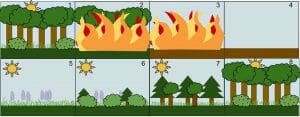Ecological Succession Definition
Ecological succession is a term developed by botanists to describe the change in structure of a community of different species, or ecosystem. The concept of ecological succession arose from a desire to understand how large and complex ecosystems like forests can exist in places known to be recently formed, such as volcanic islands. The different types of ecological succession exists during different phases of an ecosystem, and depend on how developed that ecosystem is. In the concept of ecological succession, ecosystems advance until they reach a climax community. In the climax community, all of the resources are efficiently used and the total mass of vegetation maxes out. Many forests that have not been disturbed in many years are examples of a climax community.
Types of Ecological Succession
Primary Succession
When the planet first formed, there was no soil. Hot magma and cold water make hard rocks, as seen by newly formed islands. Primary ecological succession is the process of small organisms and erosion breaking down these rocks into soil. Soil is then the foundation for higher forms of plant life. These higher forms can produce food for animals, which can then populate the area as well. Eventually, a barren landscape of rocks will progress through primary ecological succession to become a climax community. After years and years, the soil layer increases in thickness and harbors many nutrients and beneficial bacteria that are required to support advanced plant life. If this primary ecosystem is disturbed and wiped out, secondary succession can take place.
Secondary Succession
The above graphic is an example of secondary ecological succession. The first picture displays a climax community. As the frames progress, the community is destroyed by a fire. As long as the fire does not burn hot enough to destroy the soil and the organisms it harbors, secondary ecological succession will take place. As seen in frame 5, small plants will come back first. After they create a solid layer of vegetation, larger plants will be able to take root and become established. At first, small shrubs and trees will dominate. As the trees grow, they will begin to block the light from most of the ground, which will change the structure of the species below the canopy. Eventually (frame 8), the ecosystem will arrive at a climax community, which may or may not be the similar to the original community. It all depends on which species colonize the area, and which seeds are able to germinate and thrive.
Cyclic Succession
Cyclic ecological succession happens within established communities and is merely a changing of the structure of the ecosystem on a cyclical basis. Some plants thrive at certain times of the year, and lay dormant the rest. Other organism, like cicadas, lay dormant for many years and emerge all at once, drastically changing the ecosystem.
Examples of Ecological Succession
Acadia National Park
Acadia National Park, in Maine, suffered a large wildfire in 1947 of over 10,000 acres. Being nearly 20% of the parks size, many were concerned that the park would be destroyed forever. Restoration efforts were left to nature however, and many think that the choice to not intervene paid off. While the first years were ugly, and only small plants could colonize the burnt soil, many years has led to a great amount of diversity in the tree species. While the trees before the fire were mostly evergreen trees, deciduous forests now dominate the landscape. This example shows how quickly secondary ecological succession can change a landscape.
Coral Reef Ecological Succession
While ecological succession is a term coined by botanist, it also applies heavily to animal population that go through a disruption. Take, for instance, a coral reef. The coral reef as an ecosystem did not just pop into existence, but like many plant communities had to be formed over time through ecological succession. The primary ecological succession in a coral reef is the colonizing of rocks by small coral polyps. These polyps will grow and divide many times to create coral colonies. The shapes and shelter of the coral colonies eventually attract small fish and crustaceans that live in an around the coral. Smaller fish are food for larger fish, and eventually a fully functioning coral reef exists. The principles of ecological succession, while developed in context to plants, exists in all established ecosystems.
Related Biology Terms
- Ecology – The study of how different organisms fit within ecosystems.
- Ecosystem – A group of communities that are intertwined through nutrient and water cycles.
- Community – A group of species that interact with one another.
- Population – A group of organisms of the same species that interbreed.
Quiz
1. A negligent camper starts a fire in a forest. The fire burns so hot that the soil is sterilized. No bacteria, or recognizable nutrients, are left for organisms to use. Which of the following forms of ecological succession must take place?
A. Primary Succession
B. Secondary Succession
C. Cyclical Succession
2. Due to a wildfire, the coats of a certain species of fox tend to get greyer in color. When the plants of the forest regenerate over time, the foxes become closer to black. Is this an example of ecological succession?
A. Yes
B. No
C. Only if the foxes eat the plants
3. At places deep below the ocean’s surface, the sea floor is exposed to thermal vents that carry heat and sulfurous gases to the surface. While these vents are surely lifeless when they form, certain organisms soon colonize the vents. First, bacteria that convert sulfur to energy are found. On older vents, entire communities containing fish and crustaceans are found. What is this an example of?
A. Primary ecological succession
B. Secondary ecological succession
C. Cyclical ecological succession

